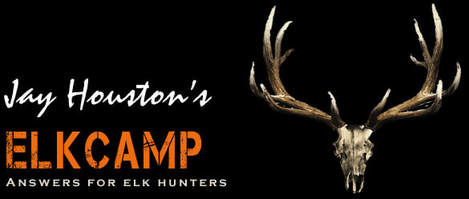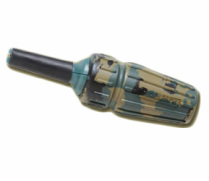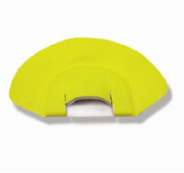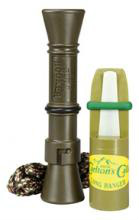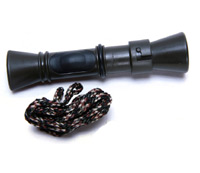Types of Cow Calls
|
There are basically two types of cow calls, the mouth call or diaphragm, and the reed call. Both types have proven to be extremely effective in almost every elk-hunting situation; the basic difference being the amount of time it takes the novice to learn use the call.
In my opinion, the mouth call or diaphragm is the better choice for a number of reasons: 1) Once in place in the mouth, it doesn’t require any external body motion to use it. Your hands can remain still and are free to hold onto your bow or rifle. This may not seem to be such a big deal to the rifle hunter who expects to encounter elk at long range, but for the bow hunter who must get in close for the shot, it can get a little tricky holding a bow with one hand, drawing with another, and attempting to hold onto a reed type call at the same time. In such situations, diaphragms are clearly superior. 2) Diaphragms are capable of producing what most veteran callers agree is a clearer and smoother reproduction of those sounds actually produced by cow and calf elk. 3) Diaphragms can be used in conjunction with grunt tubes to extend the range of the call or even help to redirect the sound of the call. This last part is important. When an elk hears a call, like humans, it will attempt to determine not only who is calling but also from where they are calling. If the hunter is directing his call straight towards the elk, the elk are going to be able to zone in on the hunter, which may not always be a good thing. By using a mouth call in conjunction with a grunt tube, the smart elk hunter can redirect the sound of the call by bending the tube to the side or rearwards, thereby causing the sound to appear to the elk to have come from somewhere other than the hunter’s position. This head fake often causes the elk to come in on the hunter’s right or left making for a broadside shot rather than a difficult head on shot. The only downside to using a mouth call is learning to use it. Unlike reed type calls, which are almost fool proof, diaphragms do require a bit of practice and some getting used to. Because diaphragms fit into the roof of one’s mouth, some folks find that there is a tendency to gag, which is a normal reaction to something large and foreign in the mouth. When I was first learning to use a mouth call, I had this same problem. Some folks are prone to this reflex action, while others never notice it. Tip: The key that I found to overcoming the gag reflex was to place the call in the side of my mouth outside of my teeth. It didn’t seem to make any difference if it was in the upper half of my mouth or the lower half, all that mattered was that because it was there, my brain began to adjust to the presence of this foreign object in my mouth. The longer I left it there, the less I thought about it. The less I thought about it, the less the gag reflex. After a few minutes, I found that I was able to move the call into place with my tongue at the front part of my pallet. From time to time, early on, the gag reflex may come back. If it does, move the call back to the side of your mouth. Don’t take it out all the way unless you think that you are going to swallow it. The longer you can leave the call in your mouth, the quicker you will adjust and can then begin to use the call. My focus here is not to teach you how to use a call, but to help you make some informed decisions on your options of which calls to use. If you want to learn more, check out our books in our online store. Reed type calls are a great alternative to the mouth call for the new elk hunter. These calls are mostly barrel type calls with a mouthpiece on the front end of the barrel and a plastic or other synthetic reed inserted into the mouthpiece. The caller simply inserts the mouthpiece about ¼ inch into his mouth, bites down gently and blows. This action causes air to move over the surface of the reed, which then vibrates and produces a sound that is amplified through the barrel. The caller controls pitch and volume by the pressure on the bite (less pressure equals lower sounds, more bite pressure equals higher tones) and the amount of air pressure blowing through the call. Reed calls are very easy to learn to use. I use an Ace-1 cow call from Sceery. It sells for around $22.95 and can be purchased with an instructional tape at most suppliers. I’ve used many other cow calls and still do, but for the beginner, the Sceery Ace-1 is tough to beat. One of the best ways to learn to use either type of call is to purchase a CD or cassette tape of elk calls available from most suppliers and then mimic the calls on the tape with your call. Tip: Where you accomplish all this practice is entirely up to you, but experience has taught many of us who have been there not to try this in the house. Unless you are one of the fortunate few who has a very…very understanding spouse when it comes to disturbing the peace in the home, you may want to do this in the car or truck on the way to or from work. When to Call and When to Hush When to Call & When to Hush Remember the line in the old Kenny Rogers song “you’ve got to know when to hold ‘em, know when to fold ‘em.” If you want to be successful at calling elk, a similar rule applies, you need to know when to call and you need to know when to be quiet. Elk are not all that different from us in the way they communicate with each other. Human communication is a two-way affair. If you say something to me or ask me a question, it provokes a response, or for each action there is a reaction. If you start talking to me and I fail to respond, you may determine that I’ve lost interest and you will probably stop talking. Elk behave similarly. Unless there are outside influences, they may carry on conversations throughout the day as long as someone is talking back, whether it is another cow, their calf, or someone who sounds like another elk. My rule of thumb is, once I have established a conversation, keep talking, keep the conversation going, and keep the interest level up until the elk begins to move so close as to be able to distinguish that you are not the real deal. How close is close can depend on factors such as cover, terrain, weather, wind, etc. Factors that would extend or reduce the elk’s ability to detect the sound that they believe to be a real elk, and determine that it is really you. Like talking to another human, suggestive calling tends to work better than aggressive calling. There are exceptions to this rule, i.e. calling bulls during the rut, but over all persuasion appears to work better. If you are working a bull that is all fired up during the rut, you may want to try to sound more aggressive, more threatening. Some bulls will respond in kind and come charging towards the call attempting to drive off a potential threat. On the other hand, he may gather up his harem and hightail it right outta there. Aggressive calling is always risky, but may be the only way to lure the bull your way. If you do manage to bring in one of these monsters, be ready! This is especially true for bowhunters who must wait until they almost can see the whites, or in some cases red, of the bull’s eyes before taking a shot. In such cases, I might think about having a large tree handy that I could get behind, if that bad boy gets too close. Finally, a smart elk hunter knows when to be quiet. As mentioned above, once the elk is in close or you think that he may have located you, it’s time to hush, get ready, and keep your eyes open to any kind of movement. Remember the earlier story of the two guys on horseback hootin’ and hootin’ on their cow calls? While elk do talk considerably throughout the day, the same elk doesn’t talk every second. Just like humans, too much talk can have an adverse reaction with elk as well. Communication whether with people or elk is a balance of listening and responding. If you are ever fortunate enough to find yourself within hearing range of a herd of elk, take the time to listen to them for a while. I’ve done this many times, but my focus is usually on the hunting or learning to imitate the sounds of their talk. By listening to the conversations, we can learn not only the sounds, but we can learn how the dialog plays out, the nuance of the communication process, even if we cannot understand it. If there are a lot of cows and calves there will surely be a lot of conversation, but not all from the same elk. Tip: Cow calling should resemble a persuasive conversation, not a contest to see who can talk the most or the loudest. It’s about building a relationship. Think about talking to your wife. Which works best gentle persuasion or yelling? I think that most of you will get the point. Enough said! Some calls that work well include:
Those who seek knowledge kill more elk than those who do not! For a lot more information on elk and elk hunting please consider purchasing one or all of my top-selling books on the subject.Click here. |
